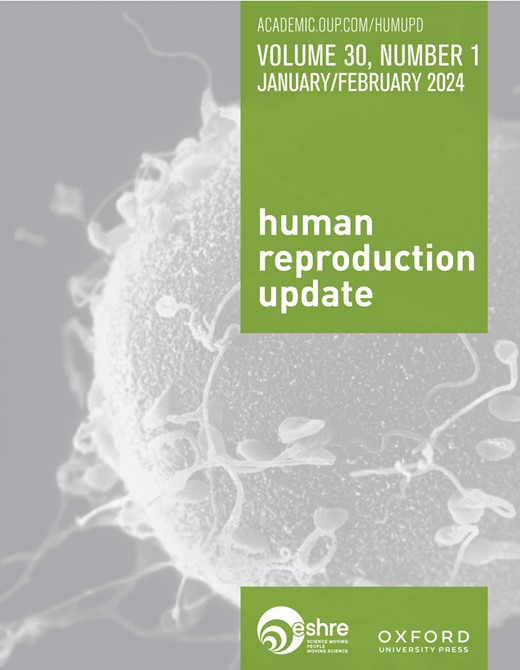rna结合蛋白的复杂舞蹈:揭示男性不育背后的机制
IF 16.1
1区 医学
Q1 OBSTETRICS & GYNECOLOGY
引用次数: 0
摘要
rna结合蛋白(rbp)在精子发生、生殖细胞增殖、分化和成熟的转录和转录后过程中不可或缺。尽管rbp具有公认的重要性,但其在男性不育症中的作用仍未得到充分探讨。最近,一篇开创性的科学出版物报道了在1046名不育患者中发现的1744个小鼠睾丸RBP图谱,22个功能丧失变体和137个有害错义变体,为研究它们的分子和临床相关性提供了前所未有的机会。与无精子症、少精子症、畸形精子症和弱精子症相关的rbp相关基因变异突出了它们作为诊断生物标志物和治疗靶点的潜力。然而,整合基因,功能和临床见解的综合分析仍然缺乏。目的与原理本综述旨在系统分析rbp在男性不育中的作用。利用最先进的数据集和实验见解,它检查致病变异和不确定意义变异(VUS),并阐明基因-疾病关系(gdr)。此外,它还探索了精子发生阶段已知的RBP功能,并确定了候选RBP基因。通过整合这些发现,本工作提供了一个全面的框架,以促进对rbp的遗传理解,以及它们作为男性不育症临床生物标志物和治疗靶点的潜力。我们使用关键词“rna结合蛋白”、“男性不育”、“精子发生”、“精子”、“遗传变异”、“功能分析”和“敲除小鼠模型”在PubMed数据库中检索到2025年7月13日之前的文章。从ClinVar和PubMed数据库中检索到1744个rbp编码基因的致病变异和VUS,并通过国际男性不育基因组学联盟数据库对gdr进行系统分析。评估RBP敲除小鼠模型的功能数据,以阐明精子发生中的阶段特异性作用。通过挖掘RBP图谱,以及来自基因型组织表达、人类蛋白质图谱和Uniprot数据库的数据,确定了缺乏敲除小鼠模型的候选RBP基因。本文还讨论了rbp作为诊断生物标志物和治疗靶点的临床潜力。我们的搜索产生了~ 2000条记录,331篇相关文章最终被纳入最终文本。首先,本综述在62个RBP基因中鉴定出177个致病变异,在35个RBP基因中鉴定出91个VUS,其中15个与人类男性不育有关。其次,124只RBP敲除小鼠模型的功能分析揭示了它们在精子细胞发生、精子形成和精子发生中的阶段特异性调节作用,为piwi相互作用RNA生物发生、染色质重塑和RNA稳定性等关键过程提供了见解。第三,筛选了38个缺失敲除RBP基因的小鼠模型,作为雄性不育RBP基因的候选基因,强调了它们在未来功能研究中的潜力。最后,本文讨论了rbp作为生物标志物和治疗靶点的临床潜力,包括基于rna的药物、小分子和基因编辑技术作为解决rbp相关男性不育症的创新策略。本综述强调了rbp在男性不育症中的作用,并提供了一个整合遗传、功能和临床数据的框架。通过识别候选rbp及其治疗潜力,为生殖医学未来的诊断进步和个性化治疗奠定了基础。注册号码。本文章由计算机程序翻译,如有差异,请以英文原文为准。
The intricate dance of RNA-binding proteins: unveiling the mechanisms behind male infertility
BACKGROUND RNA-binding proteins (RBPs) are indispensable for transcriptional and post-transcriptional processes during spermatogenesis, orchestrating germ cell proliferation, differentiation, and maturation. Despite their established importance, the contributions of RBPs in male infertility remain underexplored. Recently, a seminal Science publication reported an RBP atlas of 1744 murine testicular RBPs, 22 loss-of-function variants, and 137 deleterious missense variants identified in 1046 infertile patients, providing unprecedented opportunities to investigate their molecular and clinical relevance. Variants in RBP-related genes associated with azoospermia, oligozoospermia, teratozoospermia, and asthenozoospermia highlight their potential as diagnostic biomarkers and therapeutic targets. However, comprehensive analyses that integrate genetic, functional, and clinical insights are still lacking. OBJECTIVE AND RATIONALE This review aims to systematically analyze the roles of RBPs in male infertility. Leveraging state-of-the-art datasets and experimental insights, it examines pathogenic variants and variants of uncertain significance (VUS), and elucidates the gene–disease relationships (GDRs). Furthermore, it explores known RBP functions across spermatogenesis stages and identifies candidate RBP genes. By integrating these findings, this work provides a comprehensive framework to advance the genetic understanding of RBPs, and their potential as clinical biomarkers and therapeutic targets in male infertility. SEARCH METHODS We searched the PubMed database for articles until 13 July 2025, using the keywords ‘RNA-binding protein’, ‘male infertility’, ‘spermatogenesis’, ‘sperm’, ‘genetic variant’, ‘functional analyses’, and ‘knockout mouse model’. Pathogenic variants and VUS in 1744 RBP-coding genes, retrieved from the ClinVar and PubMed databases, were systematically analyzed to classify GDRs by the International Male Infertility Genomics Consortium database. Functional data from RBP knockout mouse models were assessed to elucidate stage-specific roles in spermatogenesis. Candidate RBP genes lacking knockout mouse models were identified by mining the RBP atlas, alongside data from the Genotype-Tissue Expression, Human Protein Atlas, and Uniprot databases. The clinical potential of RBPs as diagnostic biomarkers and therapeutic targets was also discussed. OUTCOMES Our search generated ∼2000 records, and 331 relevant articles were ultimately included in the final text. Firstly, this review identified 177 pathogenic variants in 62 RBP genes and 91 VUS in 35 RBP genes, 15 of which have been confidently linked to human male infertility. Secondly, functional analyses of 124 RBP knockout mouse models revealed their stage-specific regulatory roles in spermatocytogenesis, spermatidogenesis, and spermiogenesis, offering insights into key processes such as piwi-interacting RNA biogenesis, chromatin remodeling, and RNA stability. Thirdly, 38 RBP genes lacking knockout mouse models were screened as candidate RBP genes in male infertility, underscoring their potential for future functional investigations. Finally, this review discusses the clinical potential of RBPs as biomarkers and therapeutic targets, including RNA-based drugs, small molecules, and gene editing technologies as innovative strategies to address RBP-related male infertility. WIDER IMPLICATIONS This review highlights the role of RBPs in male infertility and offers a framework for integrating genetic, functional, and clinical data. By identifying candidate RBPs and their therapeutic potential, it lays the groundwork for future diagnostic advancements and personalized treatments in reproductive medicine. REGISTRATION NUMBER N/A.
求助全文
通过发布文献求助,成功后即可免费获取论文全文。
去求助
来源期刊

Human Reproduction Update
医学-妇产科学
CiteScore
28.80
自引率
1.50%
发文量
38
期刊介绍:
Human Reproduction Update is the leading journal in its field, boasting a Journal Impact FactorTM of 13.3 and ranked first in Obstetrics & Gynecology and Reproductive Biology (Source: Journal Citation ReportsTM from Clarivate, 2023). It specializes in publishing comprehensive and systematic review articles covering various aspects of human reproductive physiology and medicine.
The journal prioritizes basic, transitional, and clinical topics related to reproduction, encompassing areas such as andrology, embryology, infertility, gynaecology, pregnancy, reproductive endocrinology, reproductive epidemiology, reproductive genetics, reproductive immunology, and reproductive oncology. Human Reproduction Update is published on behalf of the European Society of Human Reproduction and Embryology (ESHRE), maintaining the highest scientific and editorial standards.
 求助内容:
求助内容: 应助结果提醒方式:
应助结果提醒方式:


